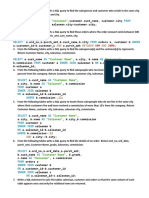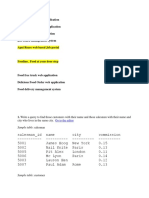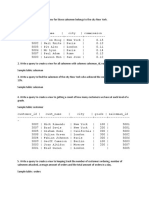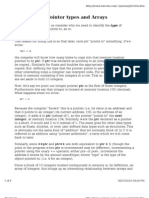0% found this document useful (0 votes)
29 views21 pagesSQL Questions
The document contains a series of SQL practice questions and their corresponding queries related to salespeople, customers, and orders. It includes tasks such as finding customers and salespeople in the same city, filtering orders by amount, and generating reports with customer and order details. Each question is accompanied by a SQL query that demonstrates how to retrieve the required information from the database.
Uploaded by
Muskan ShahCopyright
© © All Rights Reserved
We take content rights seriously. If you suspect this is your content, claim it here.
Available Formats
Download as PDF, TXT or read online on Scribd
0% found this document useful (0 votes)
29 views21 pagesSQL Questions
The document contains a series of SQL practice questions and their corresponding queries related to salespeople, customers, and orders. It includes tasks such as finding customers and salespeople in the same city, filtering orders by amount, and generating reports with customer and order details. Each question is accompanied by a SQL query that demonstrates how to retrieve the required information from the database.
Uploaded by
Muskan ShahCopyright
© © All Rights Reserved
We take content rights seriously. If you suspect this is your content, claim it here.
Available Formats
Download as PDF, TXT or read online on Scribd
/ 21






















































































